Extended Table
Municipal Kitchens
The Milpa is a Pluriversal Language: On-site activations and slow-cooking at nGbK Berlin

Follow the Pluriverse of the Milpa through Radio Cocina Colaboratorio live from Berlin and transmitting through Mensajito
Municipal Kitchens reimagines communal eating in cities. The exhibition gathers works by international and local artists and collectives that expose the current state and injustice of food systems, as well as ones that propose new forms of community-based eating. The artworks are accompanied by a weekly event program and free-of-charge communal meals, transforming the nGbK space – previously a fast food restaurant in a former market hall – into a public kitchen.
During two weeks, Cocina Colaboratorio will experiment with the design of spaces of encounter that promote Pluriverses, commonality, heterogeneity and most importantly, slow-paced cooking. Drawing on a cyclic calendar of the Milpa system, we will develop a methodology for interventions in the gallery space, exchanges, and slow-paced cooking sessions that will invite slower times in our collaboration with food. Sharing the how’s, bringing a series of concepts that we work with at Cocina Colaboratorio: assembly, collective decision-making, celebration, archiving, radio, and meeting around biocultural know-how by cooking slowly, cultivating the ethics of a “milpa”.
The milpa is a pluriversal language
In the coming two weeks this installation will be activated to archive a series of slow-cooking processes following the rhythms and cycles of the Milpa, a crop system and biocultural language that allow for corn, bean and squash to grow and sustain plural ways of doing and knowing. Within a place-based and performative approach, Cocina Colaboratorio presents a framework: a compass-map-calendar that can open up collaborative processes engaging with the ecosystems of Berlin. This framework invites us to slow-down and contemplate how seeds, cooking processes, and collaborations can grow when enacting care and commonality within our food practices.
Kindly supported by Culture Moves Europe and nGbK Berlin
Collaborators
Dea López (Co.merr)
Emilio Hernández
Elizabeth Guerrero
Nicolás Amaro
Jesper Buursink
Mariana Martínez
Visit also:
Xochimilco, Mexico City
The Traces We Leave
A day of active immersion and reflection on the role of arts in contested territories hosted by Cocina Colaboratorio Xochimilco + Food Art Research Network
Together the participants shared in a day of action and reflection. We began by walking through the streets of Xochimilco, noticing the way the water shapes the city streets. We rowed together through the canals of Xochimilco with our feet planted firmly on the boat and hearts facing the direction we wanted to go. We participated in Tequio at Chinampa Tlazoltéotl led by Gaby Ale, as a way to hold reciprocal relationships with the territory and its community. Tequio a communal way of living and sustaining local agricultural practices. After this morning of work we were invited to lunch at Chinampa Amapola del Sabor with a menu by Amapola del Sabor a womens collective who are defending the Xochimilco territory through their food practices. We held a “Digesting the territory” tea ceremony and conversation, brewing local plants for tea and we set an intention to share our experiences of the day, reflecting on our practices, our concerns and the possibility for instituting otherwise.
We gave voice to questions about the role of art and curatorial practice in contested spaces and territories. We talked about our experience with working in spaces in which tensions exist between rural and urban, between cultural and ancestral practices and between spectacle and process. We exchanged experiences, failures, wishes, successes. The conversation was hosted in three phased “Lo propio (your own), lo ajeno (the other) y lo posible (the possible)”.
Cultural and curatorial platforms that joined: Chinampa Amapola del Sabor Chinampa Tlazoltéotl Cocina Colaboratorio Duapla Molcajete Hawapi Food Art Research Network Study Pattern Collective What Could Should Curating Do? www.foodartresearch.network
Video: Rubén Garay
Video editing: Pablo Chavarría Gutiérrez
Collaborators
Mariana Martinez Balvanera
Michelle Buerba
Biljana Ciric
Madeleine Collie
Grace Gloria Denis
Maxim Holland
Zoë Heyn Jones
Emilio Hernández Martínez
Diego Astorga-De-Ita
Gabriela Alejandra Morales Valdelamar
Adriana Cadena Roa
Beatriz Paz
Susie Quillinan
Alessandro Valerio Zamora
Elvira Valle Santana
Visit also:
London, UK
Tierra Sostenible
Politics of Food Residency at Delfina Foundation, 2022
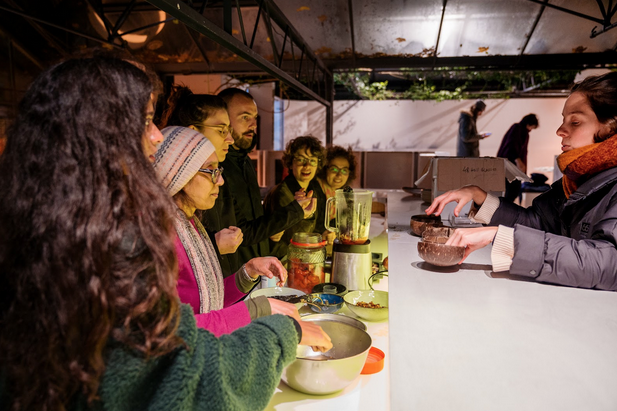
“Tierra Sostenible” was a series of four gatherings in the context of the Politics of Food, Season 5 programme at Delfina Foundation, during the autumn of 2022. These meetings were part of an active research on transformative pedagogy and socially engaged art, which aimed to create a space to question and explore the interconnections between food systems and community organisation to unveil the political potential of contemporary art, in the context of the climate change emergencies and global crisis.
Over the course of the gatherings, participants took part in an open exploration of “enunciation” – a process to think through and name the causes we care about as a starting point for enacting local change. Together, we enacted micro food activism through the act of cooking, eating and sharing and developed a collection of formulas, gestures, and practices that went beyond the mind and connected with hearts and actions.
“Tierra Sostenible”, aimed at building a framework of action for social and environmental change inspired by the principle of Comunalidad. This concept, developed by local groups in Oaxaca, Southern Mexico, highlights the territory and collectivity as the centre of organisation to imagine alternative -and more responsible- connections to nature and ourselves.
By challenging and overthrowing current practices, and collaborating to create new ones, this space brought about fruitful confrontations, rich dialogues, and a wide array of flavours, sensations, and of course, food. The act of cooking itself triggered a sense of togetherness – it unveiled a necessary group auto-organisation. Picking, washing, cutting, peeling, heating the pans. As hands became active, so did the senses, sparking an unspoken type of communication. As the ingredients got warm, a scent of subtle trust invaded the space: we were getting to know each other beyond our usual categories.
Our embodied practices and knowledge spoke too, as we moulded the food with our individual understandings, whilst learning from the others’ ways. The resulting flavours, spices, colours, and plates reflected a combination of stories. Some offered locally sourced meals. Others brought narratives from distant places.
Yet, all revealed a communal effort; a glimpse of how powerful a collective can be. When the table was set, and the dishes were served, words filled our mouths before the food did. Joint discussions contributed to provide insights on how communality confronted ourselves and the group. By recognising each other and what we cooked, waves of perspectives, emotions, and ideas of action were articulated.
The group shared the realisation that change is feasible through exchange, negotiation, empathy, and awareness – that situated efforts can inspire a network of small, but cumulative, acts of resilience. Then, we ate. We laughed and tasted. We savoured the moment. In all its beauty, celebration is also a political statement:it is an enunciation.
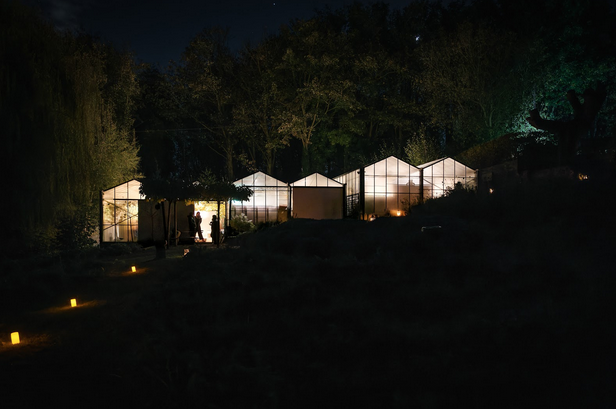
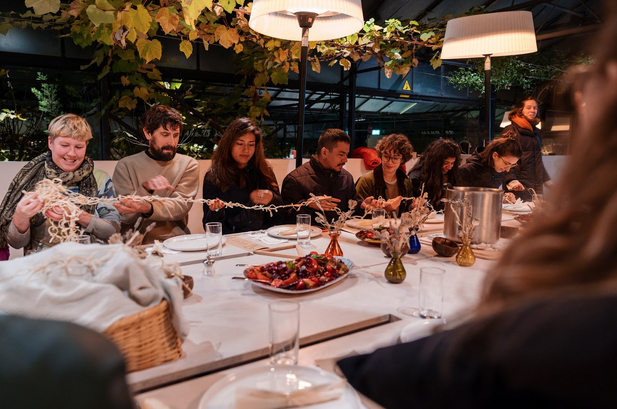




This project was presented as part of the Delfina Foundation Politics of Food Residency, 2022. Supported by the Gaia Art Foundation. With special thanks to: Karen, Sol, David and Luciane from OmVed Gardens. Andy and Louise from Makeversity. All the Delfina Foundation staff. Viviana Chechia and Yasmine Sefraoui. Cameron Cook and Jay Lee.
Collaborators
Creatives
Emilio Hernández
Researchers
Daniela Sclavo
Visit also:
Xochimilco, Ciudad de México
Expanded Program of Biocultural Living Archives
Activations, tequios, exchanges, and discussions around biocultural knowledge
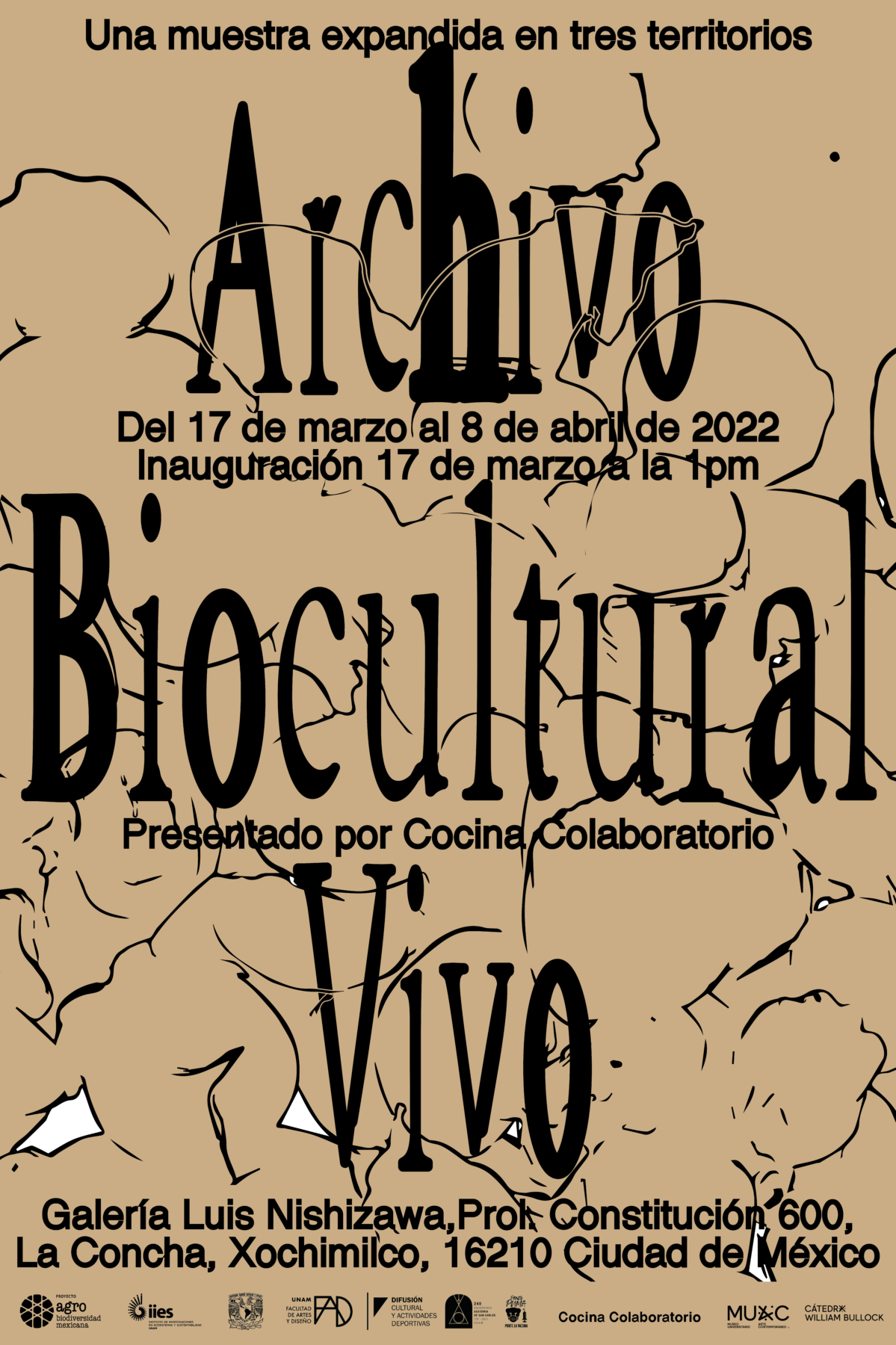
The Living Biocultural Archive is an expanded, collective, and community-based museology that connects the stories, recipes, seeds, techniques, experiences, knowledge, and local wisdom of the residents of Loma Bonita, Chiapas; Santo Domingo Tomaltepec, Oaxaca; and Xochimilco, Mexico City.
The formation of the Archive is a practice that is both situated and nomadic, living within the plots, lots, and chinampas – in their fruits and seeds, but also in the memory and voices of their inhabitants. It is both biological and cultural, reflecting centuries of interactions between nature and culture, interactions that change as landscapes and societies transform.
The archive is a portal for listening to and disseminating biocultural memory. It serves as a transdisciplinary bridge between local knowledge and academic knowledge (scientific and artistic) to weave together perspectives and explore new horizons that allow for different actions in the present and envision possible futures. Its purpose is to recognize, redefine, and preserve symbolic, cognitive, and natural memory. It also allows these memories to be contrasted with the dominant logics of food production guided by the maximization of economic benefits.

Expanded Exhibition in Xochimilco
17th to 8th march, 2022
Galería Nishizawa, FAD, Xochimilco
As part of the dissemination and expansion of the project, from March 17th to April 8th, the Biocultural Living Archive was exhibited at the Luis Nishizawa Gallery at the Faculty of Arts and Design, UNAM Xochimilco. The exhibition showcased the construction processes and logics of action of the Archive.
In the gallery, the Living Biocultural Archive was conceived as a rhizome, an interwoven network of relationships that connect and nourish each other. It became a multifunctional space, serving as a storage area, laboratory, and kitchen – a place for gathering, experimenting, and creating.
During the exhibition, the static spectator-object relationship was broken, inviting visitors to collectively create, cook, and think about objects and actions that inspire fairer and more supportive paths for food systems. Through collaborative action dynamics, all the elements that composed the exhibition and those created during the show have been gradually “un-archived” to travel and disperse throughout the public spaces of the three communities. There, they are being recontextualized and reinterpreted.
The traces of these objects, actions, and exchanges are the remnants of a process of dismantling and exodus that highlights the belonging and persistence of the Archive in the collective memory of the communities.
During the exhibition, the Nishizawa Gallery transformed into a laboratory for creation, learning, and reflection. It was activated through a weekly program that invited members of the Xochimilco community, students, academics, and the general public to participate in a reflection-action experience.
Each week, a theme related to the principles that underpin the Biocultural Living Archive was addressed, framed within a logic of critical and expanded museology.

01 Almacén
The “Almacen” (storage) of the Biocultural Living Archive addresses the themes of wandering, expansion, dispersion, and distribution, which together refer to the moments of transit (movement) activated by the mobile device in the collection and exchange of biocultural knowledge with the inhabitants of the three communities. This space in the gallery functions as an extension of the living archive that exists outside, constantly growing. It presents a living investigation in the form of seeds, audio recordings, photographs, texts, videos, among others. The gallery becomes the temporary storage for these elements, which are eventually re-inserted into specific sites.
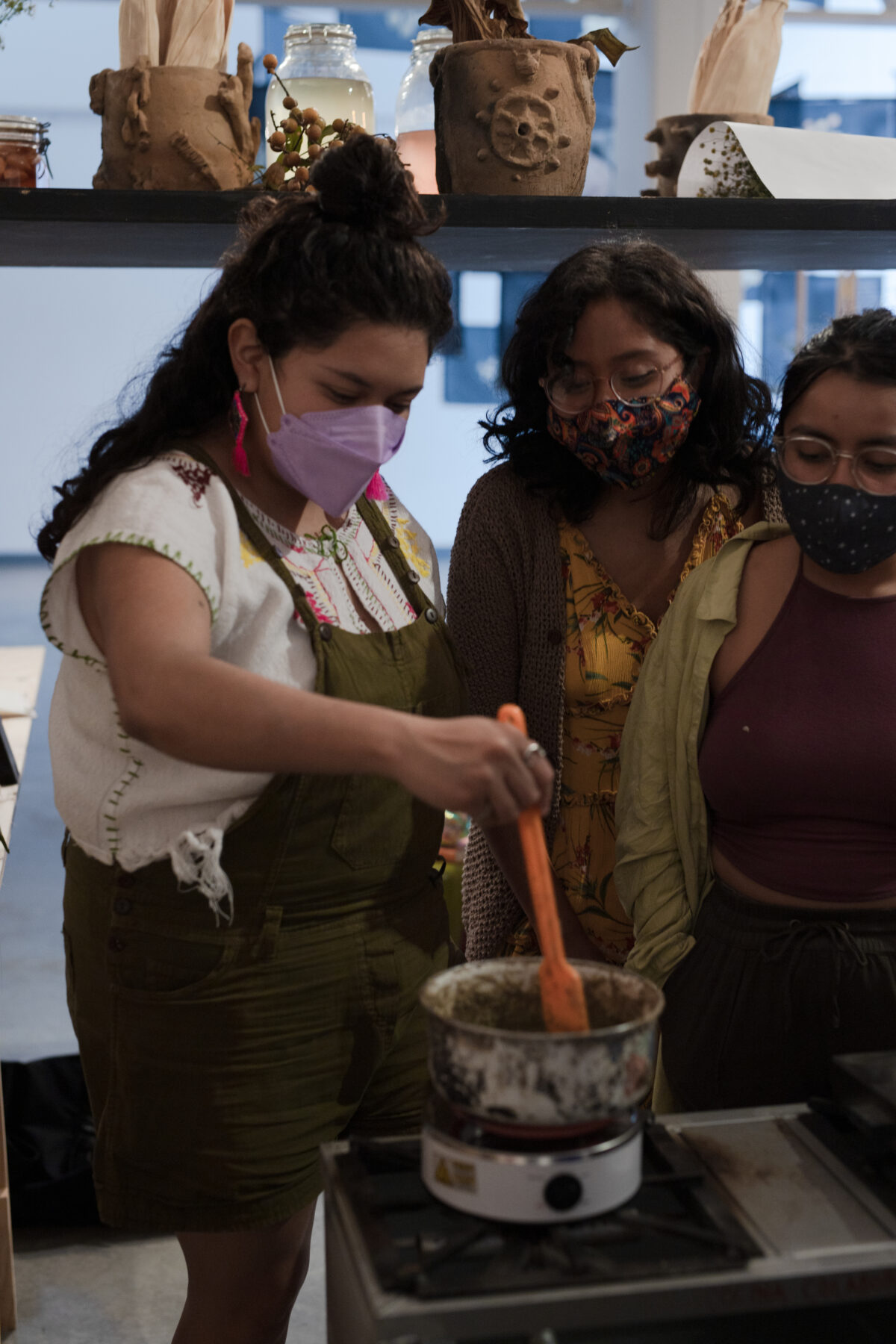




02 Laboratorio
Adaptation and embodiment are the notions at play in the Laboratory. It’s a space for action, where visitors to the exhibition, members of the Xochimilco community, and collaborators of Cocina Colaboratorio are invited to participate and co-create both inside and outside the gallery. The aim is to prototype objects and experiences for and with the people of the three communities, inspiring agentive processes and collaborative actions that pollinate or disperse the shared and co-created knowledge.


03 Cocina
The kitchen is the social space, the common place where not only food is cooked, but also stories, ideas, aspirations, initiatives, and communities. In the gallery, our meeting space is precisely the kitchen, a site activated through dialogue and physical practices that accompany the act of cooking. As we shell, peel, or select seeds, we exchange knowledge, visions, and reflections on the processes and values of the archive, memory, care, biodiversity, and resilience with guests and collaborators. It’s a space of poetic and experimental actions, much like the kitchen itself, where the time and physicality of cooking are acknowledged. A meeting place that seeks to trigger a methodology of participatory, experimental, and communal research-action that culminates in the form of a mini-publication.


Radio Bocina
The gallery space opens up an exchange with visitors on Fridays. A Radio-Bocina, an on-site radio, is set up to chat with some special guests and visitors, and other students who want to participate.

Editorial Abierta
Starting from the weekly thematic axes to propose collaborations and collective designs in the form of fanzines and/or mini publications that will serve as a bridge to the contents of the Expanded Archive.


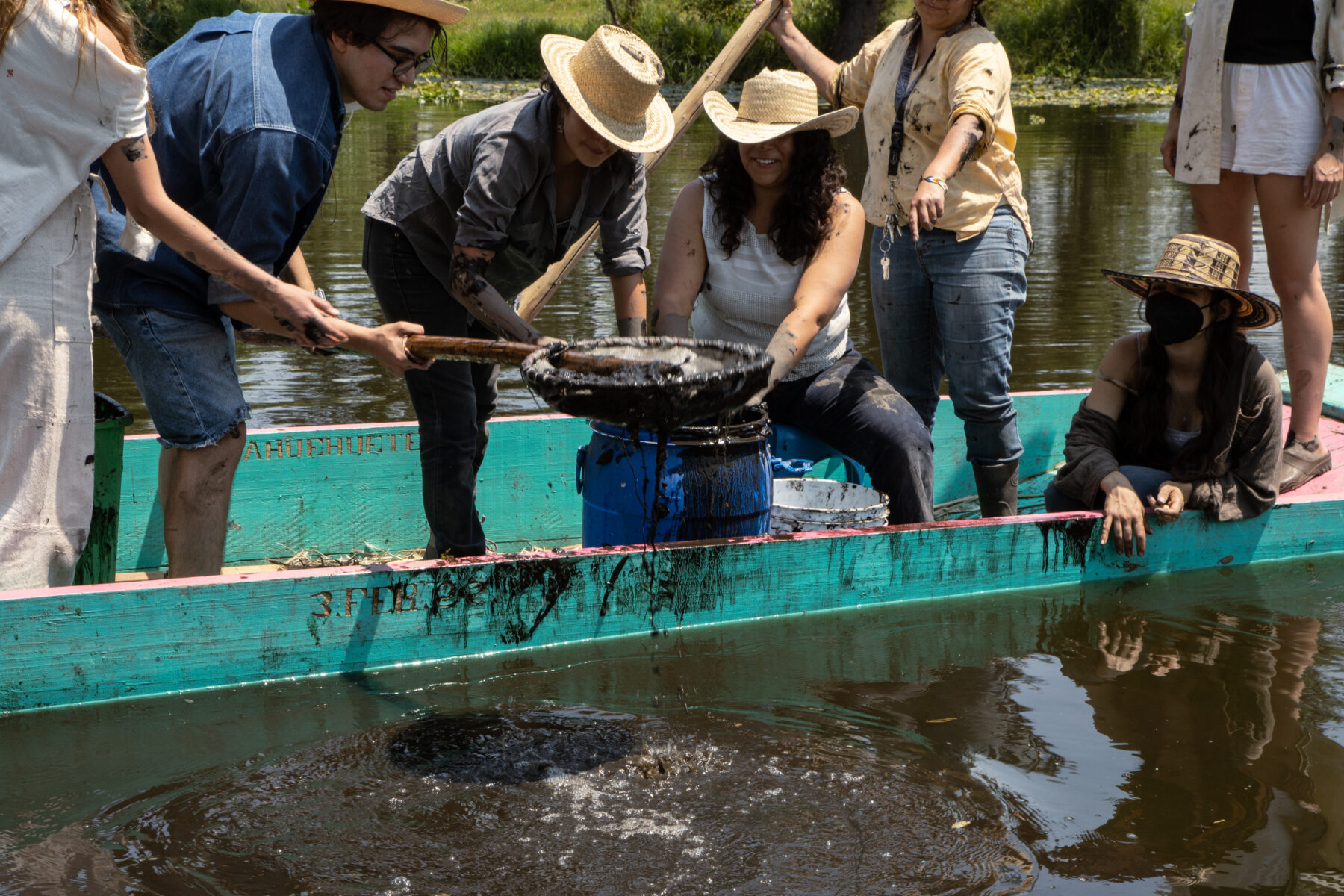

Encuentros y tequios en territorio
The meetings and Tequios (communal work sessions) in the territory took place in different plots of Xochimilco, activating actions such as building, cleaning, or planting through collective efforts. As well, public art activations helped disperse the Archive content into the streets.


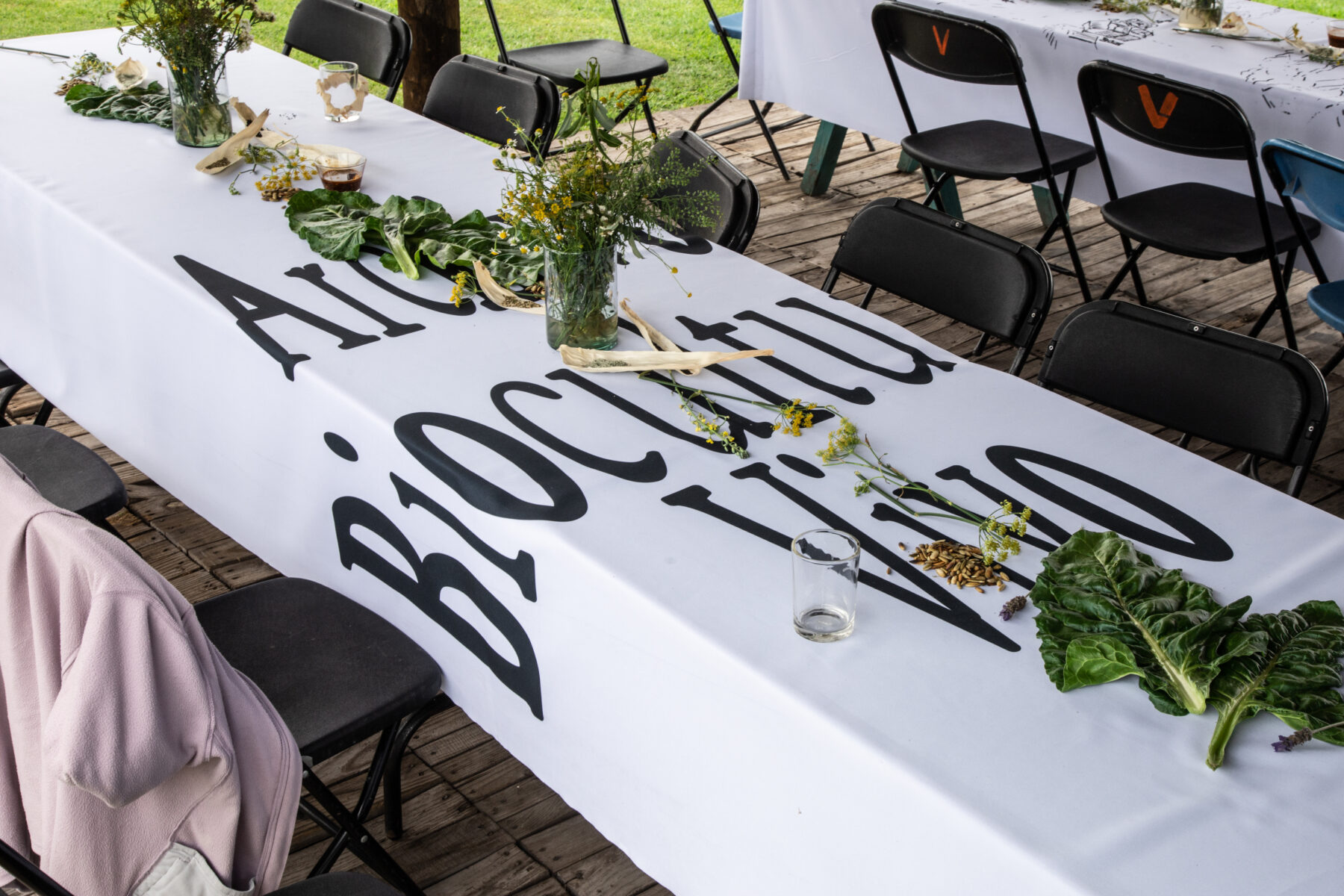

Agradecimientos
This project is made possible thanks to the support of the National Autonomous University of Mexico (UNAM) through the PAPIIT project (IV200120) granted to the Institute of Ecosystems and Sustainability Research (IIES); CONABIO through the Mexican Agrobiodiversity Project; Wageningen University (2018, 2020-2021) through the Forefront program, Reserbos Project, INREF-FOREFRONT-WUR; and the University Museum of Contemporary Art through the William Bullock Critical Museology Chair 2020.
Curaduría y Museografía (offline + online)
Design, concept, and curation: Cocina CoLaboratorio
Curatorial assistance: Pedro Ortíz Antoranz
Graphic design: Moriz Oberberger
Design and web programming: The Anderen
Invited Guests to the Program
Kitchen Tables (cocina)
Paola de Anda (Huerto Esmeralda)
Liza Covantes (Proyecto Agrobiodiversidad Mexicana)
Sarah Bak Geller (UNAM)
Nora Estrada (Cocinera Tradicional Xochimilca)
Kotik Villela y Salvador Santana (La Bandurria Marcha)
Mónica Amieva (IIE-UNAM)
Ehecátl Morales (Plan Acalli)
José Miguel González Casanova (FAD)
Santiago Robles (FAD)
Raúl Mondragón (Colectivo Ahuejote)
Martina Manterola (colectivo amasijo)
Ana de Luca (CONACYT)
Daniel Perez y Gabriela Muñoz (FAD)
Laboratorios
Laboratorio Lacustre
Leonardo Guerra
Michelle Buerba
Tanya Martínez
Grace Gloria Denis
Maestro Lorenzo Mendoza
Editorial Abierta
Erick Cruz Esquivel (Colectivo el Día de la Impresión)
María de Guadalupe Sánchez Estrada
Rubén Cerrillo García
Adriana Raggi Lucio (La Zinería)
Radio
José Sarukhan (CONABIO)
Patricia Balvanera (UNAM)
Margaux Schwab (FoodcultureDays
Gabriela Pech (Sustainable Commons)
Visit also:
Loma Bonita, Chiapas, México
Kitchen
Social Construction of a Lab Kitchen
Exchange, experimentation and collective pedagogies towards a common space

In 2021 the community of Loma Bonita presented a first plan sketch for a Lab Kitchen space on a communally owned land. This Kitchen is the result of 3 years of collective processes that have slowly built a common vision slowly materializing in this area.
Working from Loma Bonita, the CoLaboratory Kitchen transdisciplinary team has promoted participatory design, co-construction, and socialization of a long-term space that will be the heart of the activities for the exchange of knowledge and collective experimentation in a long term. This space is located on a communal plot at the edge of the Lacantún River. Working slowly on the construction of this space from participatory, collective, and social construction practices.
Since we conceived the project, we have generated a framework of collaboration and action based on the principles of constructive and experimental collectivities. Opening spaces for dialogue and also prototyping possible scenarios with activations and temporary structures, which help us to imagine these future common spaces. By sketching the space, activating and prototyping together, we have worked a form of collective community pedagogy, from local constructive, material, ecological and functional knowledge, and in pollination with technical, artistic, architectural, agro-ecological, and culinary knowledge.
Organically, this common landscape architecture has grown into an ethnobotanical garden of medicinal and edible plants of the region, platforms for activities and residents, dry toilets, and a community-designed oven with local construction practices, that have been sketched, designed, and built throughout different phases.



In November (2021) we started a collaboration with Comunal: Taller de Arquitectura, an organization that works under the democratic vision of Participatory Architecture and the Production and Social Management of Habitat, whose notions recognize that people from any social group and socio-ecological context have the ability to identify their needs, propose design solutions, make appropriate decisions for the development of their territory and collectively self-produce their habitat. With their role of integral support (technical and social), they will contribute with their experience in facilitating decision-making, collective design processes, and the social production of space, using the exchange of knowledge and critical reflection as tools for the construction of collective spaces.
Parting from the presentation made by members of the Loma Bonita community of a sketch for this Lab Kitchen, we began a detailed co-design process towards it. With two initial workshops (diagnosis and design), we were able to understand, share and reflect together on the expectations and scope of this new space, from which two design options emerged.



Participatory Diagnosis Workshop
December 2021


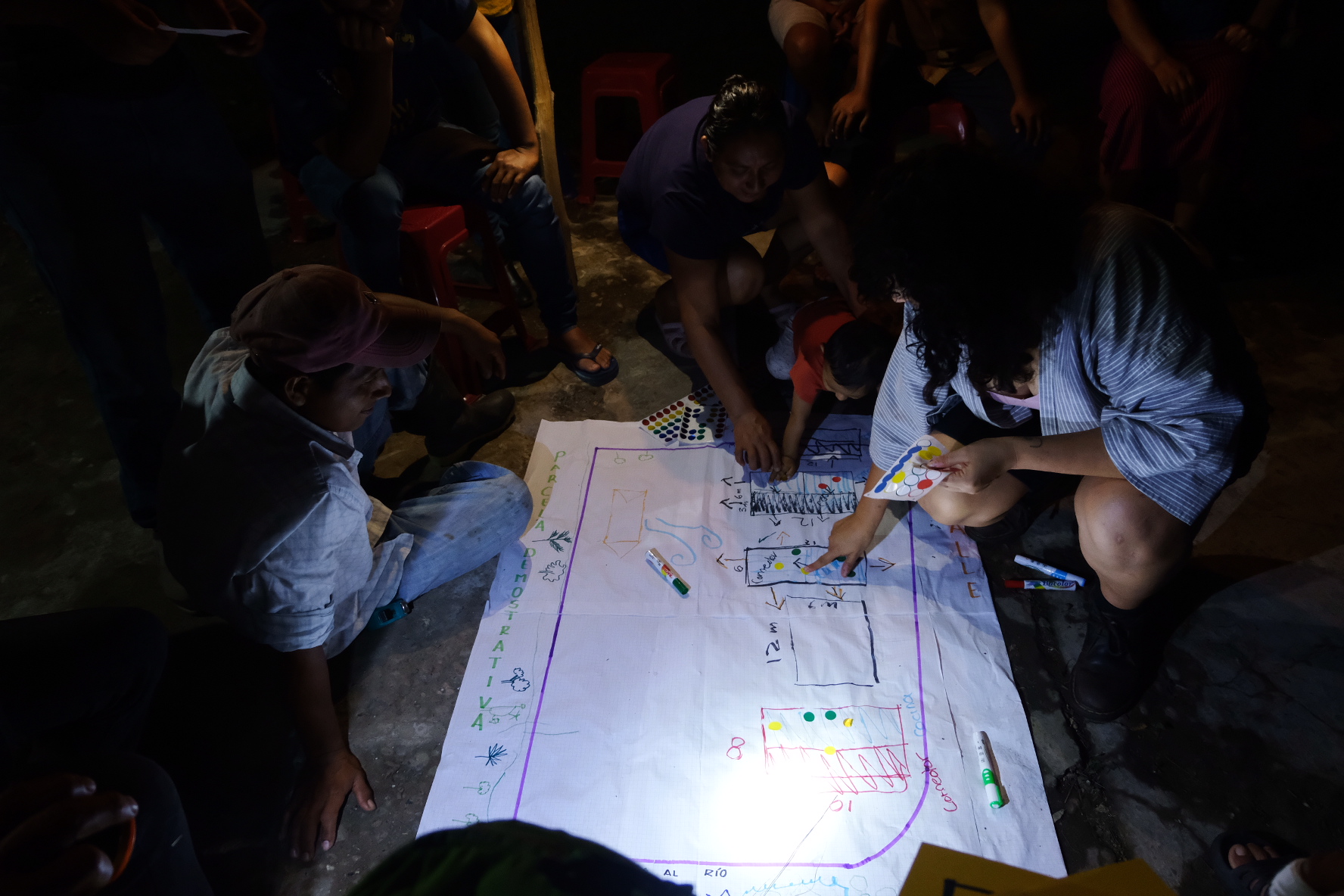
Participatory Design Workshop
December, 2021

In the following year, we will work together to define, detail and collectively validate the proposals based on the results of the first workshops and we will begin the self-production of it, involving local experts, learning regional and ancestral techniques, and using materials local to the region. Likewise, active participatory research will continue to re-learn the ways of inhabiting from a historical-narrative account of the local architecture.
This project has been a finalist in the Global Challenge 2021 de Architecture in Development, and has received an award from the Holcim Foundation to start its design and construction process.
To support and read about the progress of the project you can see more on the Architecture in Development platform. We appreciate your contribution to continue making this joint dream come true!
Collaborators
Rafa Lombera
Paco Jamangapé
Oralia García
Miguel Angel Romero
Abimael Romero
Nelva Jamangapé
Rafael Gutiérrez
Autoridades y comunidad del Ejido de Loma Bonita
Creatives
Comunal Taller de Arquitectura
Mariana Martínez
Emilio Martínez
Elizabeth Guerrero
Researchers
Diego Hernández
Monica Jaimes
Natsuho Fujisawa
Eduardo Argueta
Loma Bonita, Santo Domingo, Xochimilco, México
Biocultural Living Archives
A device that gathers samples, knowledge, practices and experiences

An exploration to visualize, archive and share the different layers of the biocultural heritage of Loma Bonita, Santo Domingo Tomaltepec and Xochimilco recently began to take shape. This exercise, called the Living Biocultural Archives, is a device that connects different ways of seeing and knowing the world through local biodiversity.
Throughout this year we will seek to co-create an archive of seeds, recipes, stories, objects and local landscapes, with the inhabitants of each community, which each one incorporates into their social life as a manifestation of their vision of the world. Although each process is developed from, in and for each specific site, it also serves as a strategic device to connect the three communities. In this way, the exchange of knowledge and know-how is promoted as a practice of community resilience.


The Living Biocultural Archive of each community is conceived as an organic museology: it is a participatory research tool, a device for exchange and networking; It is also a place for memory and its preservation, a window to recognize cultural diversity, the principles of reciprocity and above all the socio-ecological resilient practices within the confinement derived from the health crisis due to COVID- 19.
The materialization of the entire process will be a mobile device that will allow its apparition in public and semi-public spaces. This allows the project to investigate “collective making” from the limitations of the health emergency, through participation tactics that focus on interactions in open and safe spaces.
Throughout 2021, three Living Biocultural Archive devices will be built in each community. They will have the collaboration of key inhabitants, artists and researchers and different dynamics will be activated for the creation of their own content. Their designs and programs will respond to local forms, cultures and materials. Finally, during a presentation at the Luis Nishizawa Gallery in early 2022, the process of this archive can connect the three sites.
This project will be made possible thanks to the 2020 William Bullock Prize, USC Fisher Museum of Art + Patronato Fondo Arte Contemporáneo A.C. + Word of Clío A.C. of which he is the winner in 2nd place.
Visit also:
Ejido de Loma Bonita, Chiapas, México
Plot
Food Forests at the Border of the Lacandona Jungle
Towards the construction of an experimental plot with a living biocultural archive and a Lab Kitchen space

In 2020, the Colaboratory Kitchen team returned to Marqués de Comillas for a six-week fieldwork stay. Residing again in Boca de Chajúl, this year’s interventions took place mainly in the Ejido de Loma Bonita. This rural town has approximately 300 inhabitants, most of whom are non-indigenous farmers (residents of Veracruz, Michoacán and Chiapas) who subsist on food production, cattle ranching, and dairy production. Its relatively small territory and highly diverse sociocultural population make Loma Bonita one of the most vulnerable ejidos in the area. Researchers from UNAM have been investigating the regeneration of the rainforest and agricultural plots in the Loma Bonita territory for more than 20 years, a territory that has welcomed young researchers from all over the world, thanks to universities such as Wageninen University and UNAM.

During the period on site, efforts were focused on building a community plot, beginning to outline the first interventions of the Colaboratory Kitchen space. Through exchanges of knowledge with mobile kitchens, collaborative mapping activities, and a compilation of species and stories for a biocultural archive, we investigated the ingredients, biodiversity, and stories of this ejido. Throughout the 6 weeks on site, our field work was dedicated to the participatory design, co-construction and opening of a long-term space that will be the heart of the long-term activities of Cocina Colaboratorio. This space that will take place in a communal plot of the Ejido de Loma Bonita will include botanical gardens or agro-ecological plots, food forests, residence spaces for researchers, creatives and chefs, and social spaces for workshops and experimentation. The space will be the meeting and experimentation point for processes that promote fairer, more resilient and sustainable food systems.

STREET KITCHEN ACTIONS
February to March, Ejido Loma Bonita
Chefs Daniel, Jail, Nelva, Lulú, Oralia, Celina, Rafa
The Street Kitchen Action, culinary exchanges in public space, are the heart of the interactions within the on-site project. These are moments where local and transdiciplinary knowledge come together to generate new recipes, cook new visions and personal networks of affection and collaboration. From the kitchen table cooking happens with local ingredients, either from “producers” or local chefs who market their products, or from organic plots, and from tropical plants and trees found in the region, both in the populated areas like in the jungle. The central idea is to provide a platform to promote local practices and the (sometimes unknown) natural edible diversity of the area. During the 6 weeks that the team was on site, four public actions were held with different themes.


BIOCULTURAL ARCHIVE
February 20 – March 20, Ejidos of Loma Bonita and Boca de Chajúl
Between February 18 and 27, 2020, six activities related to the Co-design of a food forest were carried out in Loma Bonita. The objective of these activities was to gather and share with all the project stakeholders, the knowledge that exists about the management of local biodiversity, as well as to understand the ecological processes that are occurring and contribute to the current socio-ecological configuration of the region. First, the biologists provided a list of local “useful species” based on previous studies- plants that could potentially be used for medicinal, material or food purposes and that play a crucial role in the local ecosystem. This list was translated into a visual library: an inventory of leaves, flowers, and seeds. In a collective effort, local residents were invited to identify these plants and their relevance in terms of utility. This mapping will help to design an agro-forestry system ad hoc to the uses and customs of the community. For a mobile museum, we collected seedlings and flowers with women from the towns and experienced botanists from the area, to create an exhibition of the plants found in the community.
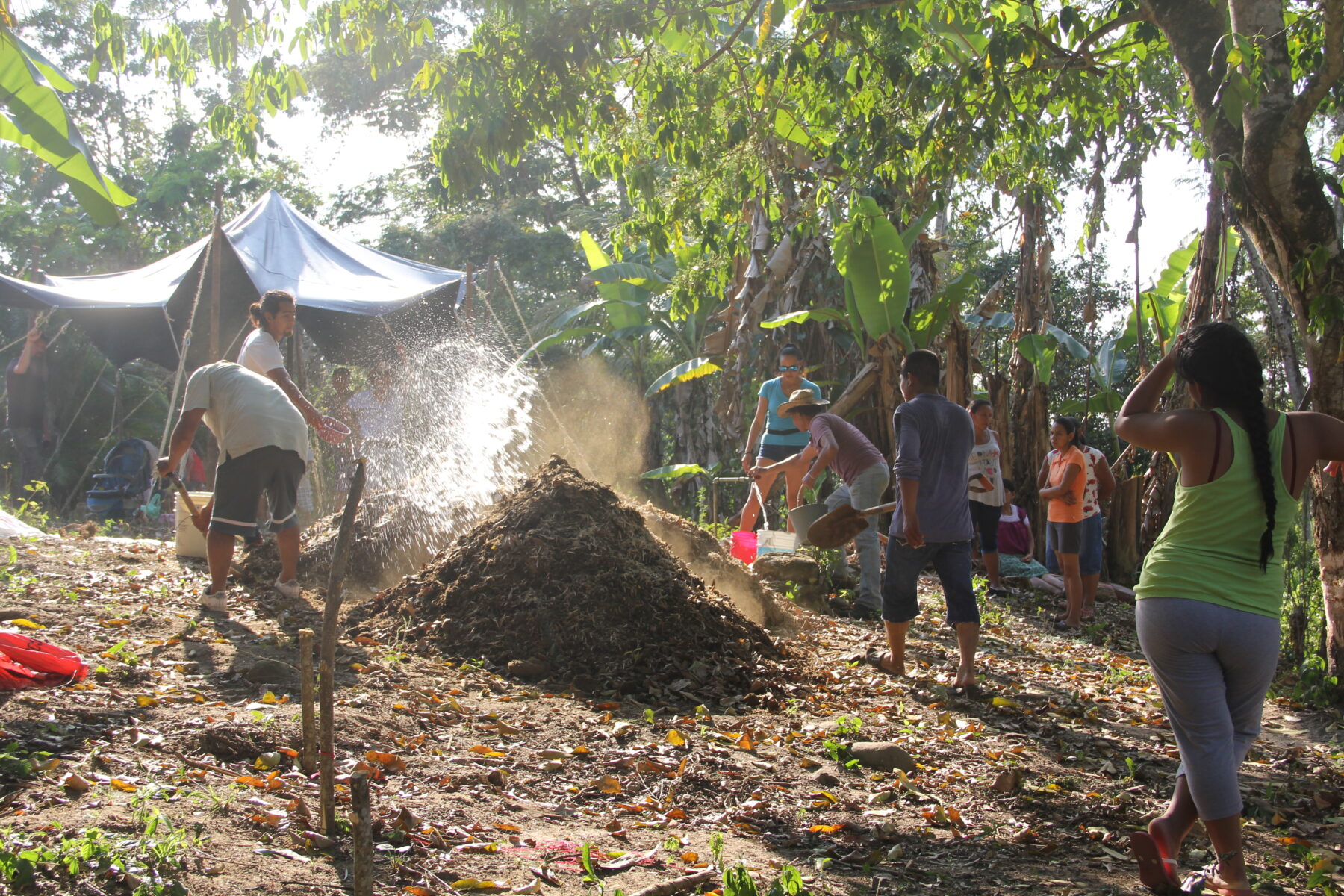

BIOCULTURAL GARDEN OF LOMA BONITA
March 9 to 19, Comunal plot in Loma Bonita
In an attempt to visually capture the myriad interconnections between the many types of local diversity, we co-built together with the community, a botanical garden – part of a living biocultural archive. On the experimental plot, we collectively planted this botanical garden over the course of two weeks, using seedlings donated by members of the community. In this way, the garden reflects the importance attributed to certain species by local residents. In addition, the garden functions as a living archive, accessible to all the inhabitants of Loma Bonita, which can be used to make cuttings and therefore reproduce endlessly. Fertile soil for the plot was prepared in parallel in the making of a Bocashi compost, a collective ritual that had to be performed every day twice a day.


TORRE MIRADOR
February 24 to 26, Communal plot in Loma Bonita
The Torre Mirador is a sculpture and a space for the admiration of the Lacandona Jungle in the Ejido of Loma Bonita. Framing the view of the river and the natural reserve of Montes Azules, the viewpoint serves as a space for reflection, a meeting place and a symbol of the community. Designed by Rob Sweere, built by Cocina Colaboratorio and the Loma Bonita community.
Colaboratory Kitchen is possible thanks to PAPIIT: National Autonomous University of Mexico (UNAM) through the Support Program for Research and Technological Innovation Projects (PAPIIT) No. IV200120 2020 – 2023 and the Wageningen University through the INREF-FOREFRONT program.
Collaborators
Producers and Community
Comunidades de Loma Bonita, Ejido Boca de Chajúl
Asamblea comunitaria y comité de autoridades de Loma Bonita
Rafael Lombera
Paco Jamangapé
Lourdes
Don Freddy
Nelva Jamangapé
Miguel
Don Jesús
Adriolo y Oralia
Celina y Don Rafa
Researchers
Biology
Miguel Martínez
Mayra Fragoso
Aline Pingarroni
Delia Caldera
Agro-ecology
Paulo Dionisio
Diego Hernández
Chemistry
Xariss Sánchez
Agronomy
Azahara Mesa
Gastronomy
Shantal Arias
Chefs
Daniel Nates
Jail Nava
Anna Kooi
Shantal Arias
Creatives
Fiona de Bell
Mariana Martínez
Roel Schoenmakkers
Teresa Borasino
Michael Bloos
Rob Sweere
Visit also:
Santo Domingo Tomaltepec, Oaxaca, México
Biocultural Living Archive
Framing the Zapotec Biocultural Heritage
Cooking and researching food in the town of Santo Domingo Tomaltepec
Santo Domingo Tomaltepec is a Zapotec town located at the center of the state of Oaxaca, in the Central Valley Region. Its ancestral roots persist to date in its festivities and culinary richness. In recent years, the urbanization processes in the region and the migration to Mexico City and the United States have impacted the social fabric leading to a loss of biocultural knowledge. The soil in this region has gradually lost fertility and the food consumption is highly dependent on external resources. The percentage of the population that dedicates full time to agriculture is decreasing every time, being the majority of the inhabitants, informal employees of bakeries, saddlery or of services in the cities of Tule and Oaxaca. There is strong pressure on the vegetation in the upper part of the basin, due to the extraction of firewood for trade.
The Colaboratory Kitchen project presents an opportunity: through innovation and reflection activities related to food production and its preparation, communication and collectivities can be strengthened. This will help create strategies to strengthen the resilience of the community to future environmental challenges and global changes. These were some of the actions that were designed on site during the first half of 2020.

TASTING SANTO DOMINGO
February 25, Santo Domingo Tomaltepec
In the traditional Oaxacan style, with band music, games and food, the project had it’s opening in the town’s square. Eleven market stalls were set up in which traditional, long-forgotten dishes prepared by local cooks were tasted, thus encouraging dialogue about food, ingredients and the customs associated with their preparation. Each dish was accompanied by a dynamic that invited us to talk about various topics: ingredients, preparation, health, the environment, the countryside, customs and tastes. For example, to accompany the “Arriera water dish”, children participated in the preparation and listened to a story. In the chickpea “amarillo” dish, soil moisture conservation was shown with a simple experiment. In addition, there were several games for children such as the quelite lottery and food puzzles, town fair style. The participants, children, women, men and the elderly, shared brief interventions to talk about food, in the Zapotec language.
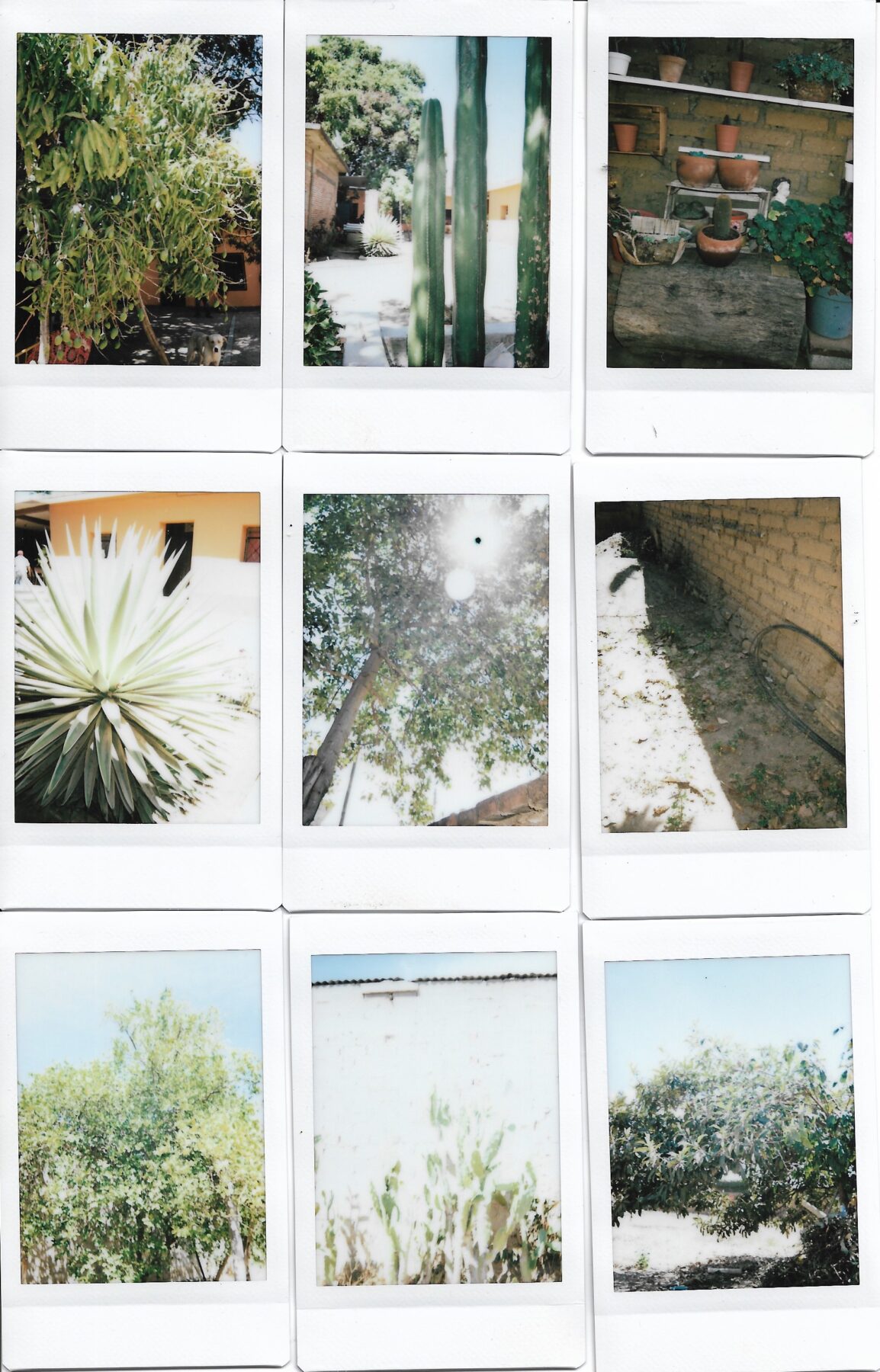
FOTOMAPING OF KITCHEN GARDENS
March 8, Santo Domingo Tomaltepec
Houses were visited in which a great variety of plants are grown for food, decoration, medicine or spice. During the visits, the women who keep the gardens, told us about what each of the plants meant for them and their garden represents for them. Doña Naty, who has 53 different plants, told us: “I spend time in my garden whenever I am no longer in the store, I take care of my plants. Since long time, we like to plant, me and my son. We sell coriander, parsley, peppermint, rabbit grass, epazote. When we have, we also sell radishes. I have medicinal plants for when it is night and there are emergencies”. On these tours, the women from each garden selected the plants that are most important to them and took pictures of them with an instant camera to later place into a map.

HISTORY OF AGRICULTURE IN SANTO DOMINGO
March 13, Santo Domingo Tomaltepec
With farmers of different ages, we elaborated the timeline of agriculture in Santo Domingo. We started the activity by sharing a dish from the field: “Sopa de Guías”. From the conversation about the rich and varied food that the milpa offers us, we have been reconstructing the main events that made a difference in the way of practicing agriculture until today.

EXPERIMENTAL KITCHEN GARDENS
April to July, Santo Domingo Tomaltepec
During the quarantine, while everyone was kept at home, members of Colaboratory Kitchen project made a “Guelaguetza” (act of sharing in Zapotec) of seeds to plant experimental gardens. From exchanges with the Santo Domingo community and based on previous agro-ecology workshops, seeds of easy-growing herbs and vegetables that are part of local recipes were selected. Each house decides how to plant its garden and throughout the quarantine and this year, they have set up a network to share experiences on how these gardens are growing. From this experiment, the authorities of Santo Domingo and the elementary school have invited us to design and co-build public experimental gardens in the school and in the main town square.
Collaborators
Producers and Community
Bernardina Martínez
Thaydée Martínez Antonio
Juan Carlos Reyes Ramírez
Josefina Hernández López
Teresa Soto González
Marcelina Soto González
Román Florentin Martínez
Ernestina Pérez
Hipólito Hernández Martínez
Paola Miguel García, coordinadora local
Ana Jarintzin Miguel Galván
Sinaí Montserrat Santiago Pérez
David Velásquez
Organisations
Pablo Ruiz Lavalle, Tierra del Sol
Rodolfo Díaz Jiménez, Fuego limpio S.A de C.V.
Victor Berrueta, GIRA
Chefs
Inés Ramírez, local cook
Juan Carlos Villegas Cuevas, Etnofood
Creatives
Emilio Hernández Martínez, Centro e Imaginación Oaxaca
Jonathan Treat, Comunicación, Tierra del Sol
Researchers
Biology, Ecology and Sustainability
Patricia Balvanera Levy, coordinator
Miguel Martínez Ramos, IIES, UNAM
Alejandra Vanessa Tauro, IIES, UNAM
Gloria Molina Gaytán, coordinator
Emma Inés Villaseñor Sánchez
Geography
Gonzálo Fernández de Castro Martínez, Instituto de Geografía, UNAM
Agroecology
Quetzalcoatl Orozco Ramirez, Instituto de Geografía, UNAM
Students
José Ramiro Ecahua Castillo
Ruth Elizabeth Pérez Martínez
Pedro Ivan Aguilar Vera
Sandra Piña Romero
Daniela Sclavo
Luz María Crystell Rosas Cruz
Visit also:
Xochimilco, Ciudad de México, , México
Plot
Exchanges in the Chinampas of Xochimilco
Pilot projects within the ancient Xochimilca landscape

Xochimilco is an emblematic town of Mexico City recognized for its beautiful biocultural waterscape which constitutes a centennial agri-food system. From pre-Hispanic times the Xochimilcas developed a network of artificial islets to plant cornfields on the wetland, using the “ahuejotes” (willow trees) and lake sediments as structure, and applying a deep knowledge about the water cycle, which resulted in a highly productive system. The collaborative work in the Chinampas guaranteed the maintenance of water quality and food production to support and provide for a large part of the great city of Tenochtitlán.
Xochimilco is made up of eleven neighborhoods, one of them is San Gregorio Atlapulco, which borders the wetland declared a protected natural area (ANP) and is part of the conservation land of Mexico City. The dramatic environmental and social decline of Xochimilco coincides with the tubing of its surface waters and the over-exploitation of the water table to supply Mexico City. Until the 1930s, the integrity and functionality of the region was maintained, to a great extent, thanks to the fact that all of its production was consumed, which was transferred to the city through interurban water channels.
However, currently the socio-ecosystem is in a critical state: the population has increased enormously, territorial planning is deficient, surface waters are highly polluted, while the local population suffers from serious shortages. The agricultural production is no longer profitable, which has led to the gradual abandonment of these activities.


Vox Populi Xochimilco
January 11, Cuemanco, Chinampas in Xochimilco and Xochimilco Market
Radio Cocina Colaboratorio
A day of daily life in Xochimilco, from work on the plot at lunchtime, to the return home on local transport. The mobile radio investigates, through the existing movements of the area, three central sites and themes of the Colaboratory Kitchen project: The plot, the kitchen and the community. Participating in the daily rhythm of the inhabitants of Xochimilco, the radio seeks to create a Vox Populi, a common vision made of individual quotes from various actors with different ages, genders and socioeconomic situations, which allows us to have a first impression of the interactions in Xochimilco. Simple and open questions give the respondent freedom to interpret their own vision on the subject. This Vox Populi is wrapped in a soundscape that places it within its physical and environmental context.

Kitchen exchange with Colective Amapola del Sabor
March 7, Canal Trancatitla, Neighbourhood “El Infiernito”
Chefs Amapola del Sabor
“Our story is simpler than it seems, the Amapola del Sabor Collective was born from countless nights around the tlecuitl (wood stove) with the family”
Colectivo Amapola del Sabor is a group of women from Xochimilco who live in a chinampa located within the protected natural area, that maintain a close relationship with the production and preparation of local food. This culinary exchange we prepared daily dishes from their family tradition, in conjunction with a family from the area. During the exchange we learned about the culinary practice in the area and related stories of food. Cooking and eating together in this natural space and informal setting allowed us to spontaneously address other issues like health, education, employment in relation to the local way of life (housing infrastructure, garden management, chickens and turkeys).

Food Stories
March 12, San Gregorio Atlapulco, Xochimilco
Older adults are a valuable source of knowledge and stories that interweave the local culture. Listening to their memories and perceptions is a very enriching way to connect with the context. In the office of Dr. Angélica Álvarez, mother of Ximena García, a member of the Colaboratory Kitchen team, Estela Nieto, Ana María Serralde, Gloria Castañeda and Florencio Martínez, elders of the community, accompanied us around the table for dinner. The guests came promptly with the typical mole that is served with chicken and rice, as well as with bean tamales. While we ate, we talked about their own life stories and the differences with those of their parents and children. An active listening and drawing workshop established a dynamic of emotional exchange. The stories that were shared, full of contrasts, were expressed through materials such as sand and drawing, simulating the flow of water in Xochimilco interweaved with memories.


Ecological Chinamperos
March 14, Paraje la Huerta, San Gregorio Atlapulco
Chinampa from Zabadiel
During the pilot, the team connected with chinamperos (farmers) who seek to produce food without agrochemicals and work collectively, fairly and respectfully with other producers. Gabriela Morales has been working for more than six years in training, awareness and marketing with producers who are interested in generating a change in the way of production and relationship with their environment. Few producers are interested in working the Chinampa, not to say in an ecological way. Zabdiel is a young chinampero conscious and proud of innovating and experimenting, who seeks to train and educate himself and his peers, concerned about the loss of biodiversity and native seeds. He taught us that there is a group that despite being a minority, has a lot of transformation potential in the area.


Water Reflection
March 16, Humedalia, Xochimilco
workshop on voice and biomaterials
We embarked on a canoe in the canals where observation, deep listening and different interventions on the landscape were triggered by Laura Estrada, a student at the Faculty of Arts and Design (FAD), with a focus on sound experimentation. During the tour Armando Tovar, collaborator of the Humedalia organization project, told us about the work that Humedalia does towards the conservation of the biodiversity of Xochimilco. Leonardo Guerra, a FAD student, presented his project about the water lily, an invasive plant native to Brazil, with which he is producing biomaterials with. Dr. Silvia Pajares from the Institute of Marine Sciences of the UNAM, who has studied the quality of the water in contrasting points of the wetland using the presence of microorganisms as biological indicators, told us about her findings regarding the presence of bacteria resistant to antibiotics sparking an intense discussion.
In this floating forum, topics such as: the causes of water eutrophication and its consequences, the presence of bacteria harmful to humans, the presence of heavy metals and the risk of consuming vegetables watered with water from the canals were discussed. Based on this exchange, strategies were proposed to follow, in the development of projects that connect these complex issues.
Collaborators
Producers and Community
Selene Lara
Karina Olmo
Alejandra de la Cruz Santiago
Leslie y Dylan Díaz de la Cruz
Aurora Mendoza
Enrique Bennetts
Ma. Francisca Moreno
Angélica Álvarez
Estela Nieto
Ana María serralde
Gloria Castañda
Florencio Martínez
Zabdiel
Sra. Imelda
Creatives
Laura Estrada, FAD, UNAM
Leonardo Guerra, FAD, UNAM
Valeria González, FAD, UNAM
Mildred Balderas, FAD, UNAM
Ximena García, FAD, UNAM
Pedro Ortíz Antoranz, FAD, UNAM
Chefs
Colectivo Amapola del Sabor
Elvira Valle Santana
Laura Valle Santana
Paola Valle Santana
Familiares (en especial a: Zenaida y Guadalupe)
Gastronomy Anthropologists
José A. Vázquez, Universidad del Claustro de Sor Juana
Ximena Vázquez Universidad del Claustro de Sor Juana
Researchers
Biology
Tanya González, Facultad de Ciencias, UNAM
Lucía Almeida, Facultad de Ciencias, UNAM
Julieta Rosell, Instituto de Ecología, UNAM
Nuria Flores Abreu, Coordinación Transversal y de Xochimilco
Social Work
Monserrat González Montaño, Facultad de Trabajo Social, UNAM
Karen Molina, Facultad de Trabajo Social, UNAM
Sustainability
Ayari Pasquier, COUS, UNAM
Juliana Merçon, Universidad Veracruzana
Nadia X. Briseño, Universidad de Guadalajara
Mónica Jaimes, UAM Xochimilco
Irving Hernández, CIBAC
Economics
Dania López, CLASCO
Boris Marañon, , Instituto de Investigaciones Económicas
Social Sciences
Rafael Calderón, UAM Cuajimalpa
Teresa Gómez, UAM Cuajimalpa
Eco-tecnologies
Montserrat Serrano, IIIES, UNAM
Omar Massera, IIIES, UNAM
Science Communication
Clementina Equihua, Instituto de Ecología, UNAM
Mario Zavala, Facultad de Ciencias, UNAM
Armando Martínez, Facultad de Ciencias, UNAM
Iván Fuentes, Facultad de Ciencias, UNAM
Local Organisations
Gabriela A. Morales, Bióloga de la Facultad de Ciencias, UNAM / Mano Vuelta / Cafetería el Ahuehuete
Maya Rubio, Instituto de Biología, UNAM/ Humedalia AC
Armando Tovar, Instituto de Biología, UNAM/ Humedalia, AC
Visit also:
Santo Domingo Tomaltepec, Xochimilco, Loma Bonita, México
Colaboratory Kitchen Sets Up in Three Communities of Mexico
A long term research, action, creation and teaching curriculum to build fairer and more sustainable agro-food systems
Developing strategies for climate action is more urgent than ever now it is evident that global politics are failing to take the necessary steps to realise the sustainability goals and stop global warming. Climate action to stop global warming is undeniably one of the most urgent topics of our time.
The Colaboratory Kitchen – Cocina Colaboratorio project was launched in 2020 as a PAPIIT project of the National Autonomous University of Mexico, a proposal to bring the knowledge from Universities and actors from different disciplines to three communities, to build upon different forms of knowledge joint actions towards sustainable futures. The search for local, national and global sustainability can be achieved by trans-disciplinary work. This model for co-production of knowledge towards sustainable alternatives requires: being located in the specific context and place, recognising the different world views, and promoting constant process of mutual learning through care networks.
In early 2018, Cascoland began a Colaboratory Kitchen (Keepers Lab&Kitchen) pilot in Chiapas, southern Mexico, in close collaboration with Wageningen University & Research (WUR) and the National Autonomous University of Mexico (UNAM). Just two years later, Cascoland and UNAM have developed a 3-year trans-disciplinary curriculum around this concept. The Colaboratory Kitchen is a project of action, co-creation, teaching and research in the search for fairer, more resilient and sustainable agro-food systems. The Kitchen is the heart of the project where daily encounters take place, initiating actions towards the landscape, the plot, the community, the environment. Creative practices, food and social the design of communication spaces are the catalysers for inspiration and exchange.
For 3 years, different actions will be carried out in three communities: Marqués de Comillas, Chiapas, Santo Domingo Tomalpec, Oaxaca, and Xochimilco, Mexico City. Marqués de Comillas, Chiapass, faces an accelerated deforestation of a diverse tropical forest, while in Santo Domingo, Oaxaca, the ancestral Zapotec biocultural heritage is at risk due to increasing globalization, and in Xochimilco, Mexico City, the impacts of urban growth are combined with ancestral agricultural roots and oportunities from the city. During the three years, new collaboration networks will be formed by bringing together local actors of the three communities with academics, students and professionals from different branches of the biophysical, social, humanities, artists, designers, and chefs to set a transformation in motion. These long term transformations will focus on deviating from the processes that have generated injustices and environmental degradation in these location. Collaborations between UNAM, the University of Wageningen (Netherlands), the international collective of artists and designers Cascoland, universities and national organizations, will contribute to the development of temporary and permanent communication spaces on the three locations.
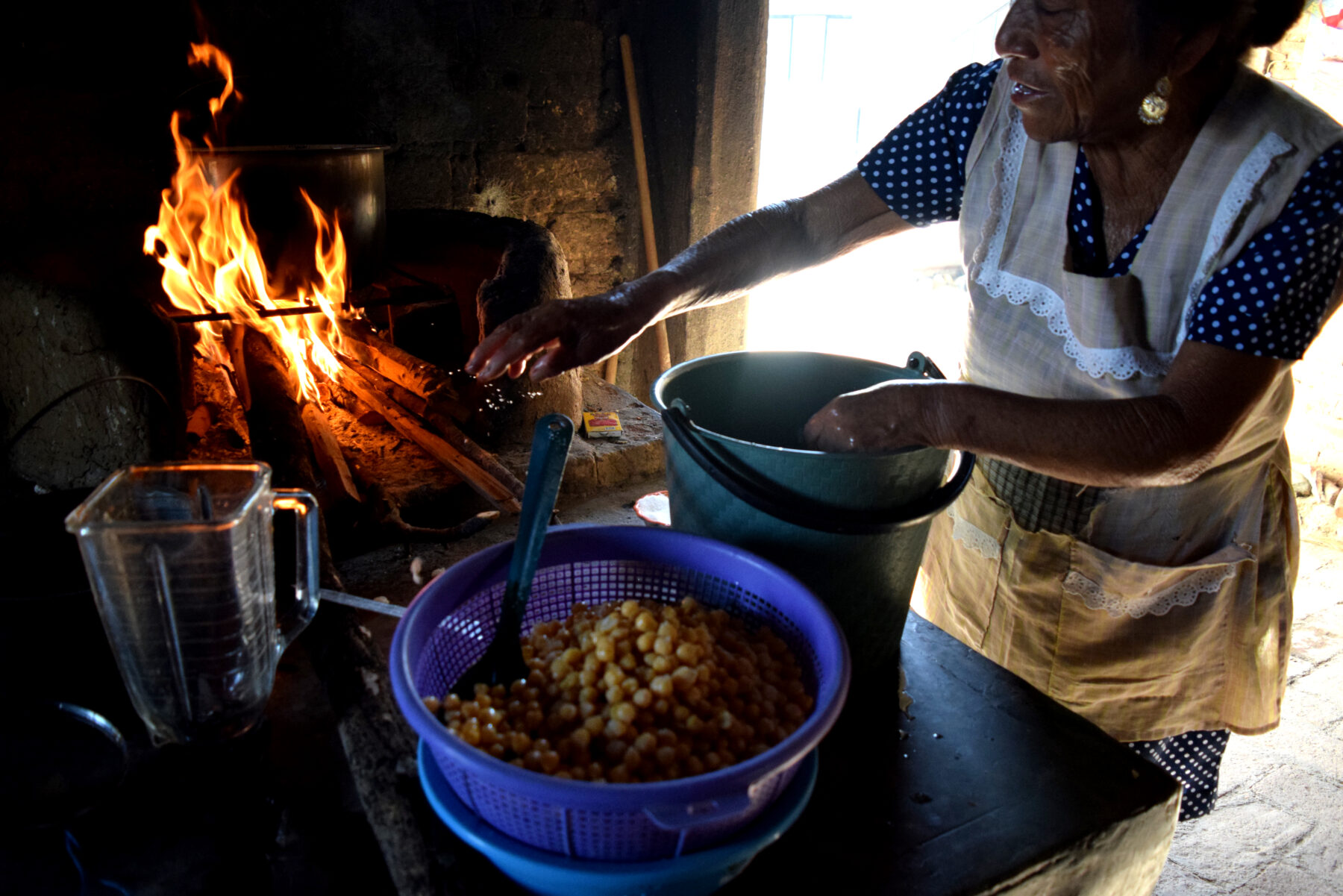


The next phase of Colaboratory Kitchen was launched at a meeting in late January 2020 where the project participants met and exchanged the first ideas. The trans-disciplinary teams will be present at the three sites simultaneously between the months of February and April of this year. UNAM researchers and students, Cascoland creatives and other collaborators will work closely together to begin developing a new interdisciplinary form of academic work and research, mobilising local communities to participate and begin building and activating knowledge exchange spaces on the long term.
We invite you all to join us at the kitchen table!
Cocina Colaboratorio – Colaboratory Kitchen is made possible thanks to the National Autonomous University of Mexico (UNAM) through the Program of Support for Research Projects and Technological Innovation (PAPIIT), Grant No. IV200120 2020 – 2023 and Wageningen University through the INREF-FOREFRONT program.
Marqués de Comillas, Chiapas, México
Kitchen
Exchanges Around the Kitchen Table
Farmer’s table and Circularity table
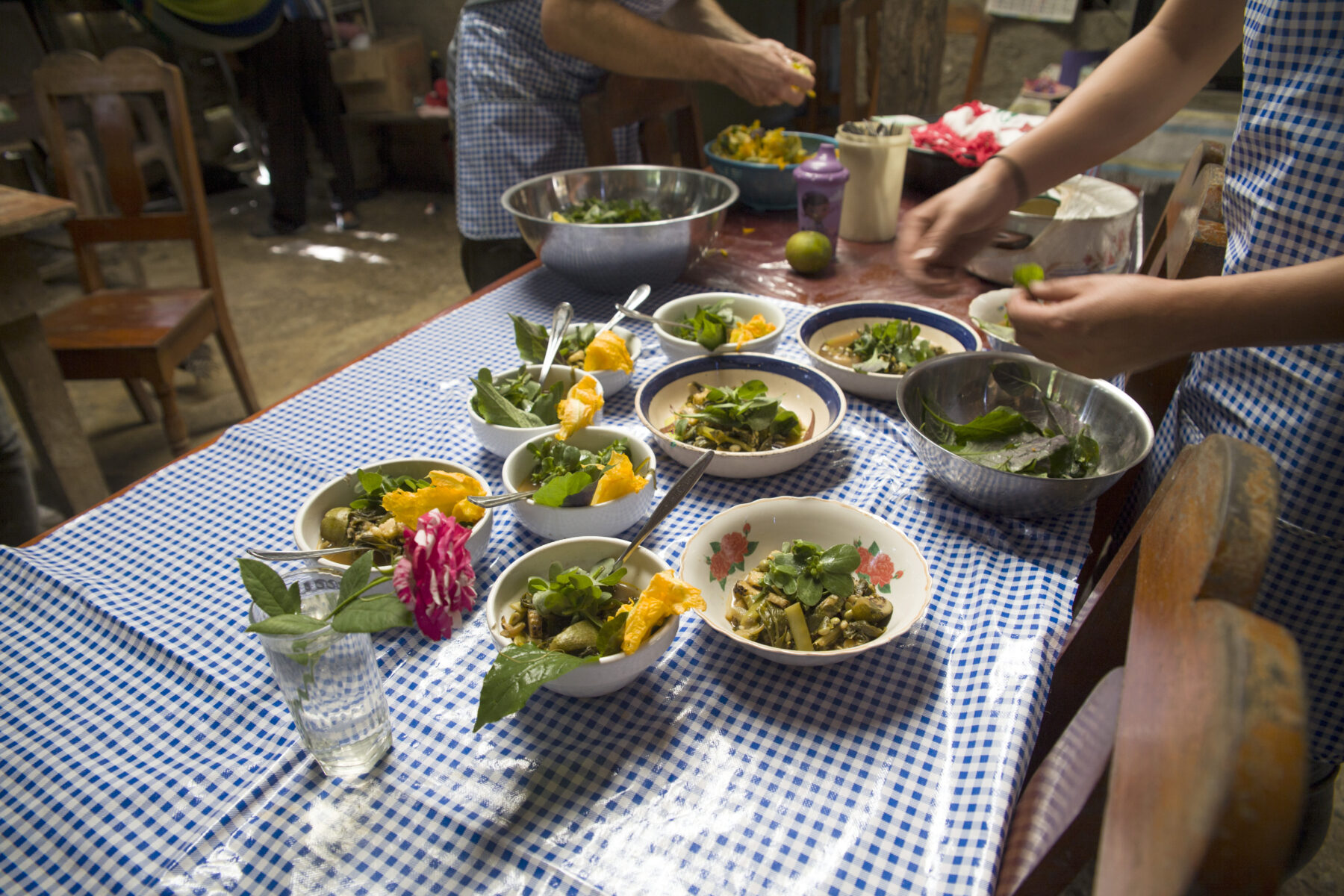
During the week of the 5th to the 11th February, a visiting group of 15 scientists from FOREFRONT- coming from UNAM, WUR and the University of Michigan- became participants in the project in what we called the “Academic Week”. The ecologists, sociologists and biologists in these groups with diverse study approaches, have been active in the area already since 30 years, others have just started with the program. To engage in this process, Cascoland generated a programming of exchange and collaboration between farmers and local producers, organisations, key members of the community and leaders, to join literally around the kitchen table.
Part of this programming was dedicated to specific community key actors, whom expressed curiosity for the study subjects from FOREFRONT. The academics had the chance to understand diverse perspectives by being exposed to stories in conversations with the producers. Around the kitchen table, they sat and exchanged while tasting dishes created by chefs Daniel Nates and Pau Ballesteros, with ingredients grown by the farmers themselves in organic ways.


FARMER’S TABLES SUBJECT EXCHANGE
February 6th, Ejido Boca de Chajul
Chefs Pau and Daniel
Based on diverse themes, we connected farmers/landowners with scientists around their kitchen tables, with the intention to generate dialogues on subjects of interest to both parties. Thom Kuyper, WUR ecologist with studies on soil composition, sat on the table with Rafael Martinez, landowner who has experimented with different ways to make compost as a way to regenerate soil fertility, for example. The subject tables were: soil fertility, edible forests, organic production, fertilisers and their biological effects. The chefs, who collected ingredients from the farmers parcels that same morning, offered a lunch to compliment the act of sharing around the kitchen tables.


ROUND TABLE: CIRCULAR GARDENS
February 9th, Ejido Reforma Agraria
Chefs Pau Ballesteros and Daniel Nates
Las Guacamayas is an ecoturistic project run by the community of Reforma Agraria that has had much success the last 10 years. In their last project, they decided to make an organic kitchen garden of half a hectare, inside the hotel grounds. With this garden they plan to feed the animals they keep there, but why not also feed their guests? Cascoland planned, alongside the local authorities, the farmer in charge and cooks, a dinner where scientists and community members could exchange ideas on their kitchen garden and circular sustainable systems. Around a set of tables arranged in a circular way, a game was proposed in which the diner exchanged seats every time a dish prepared with fresh products from the kitchen garden, was presented at the table.
Visit also:
Marqués de Comillas, Chiapas, México
Street Kitchen Actions
Boca de Chajul, El Pirú, Flor de Marqués, Boca de Chajul and Loma Bonita
During the time in Marques de Comillas, the Cascoland team traveled to 5 “ejidos” with a mobile kitchen table on a van. In each of the “ejidos” they searched for outstanding farmers, ingredients growing in kitchen gardens and knowledge of foods from the jungle. During this research connections were made with groups of producers, cooks, farmers and members of the communities that were interested in this culinary and cultural exchange.
Cascoland asked three chefs to join their team during the pilot: Pau Ballesteros (Spain), Alam Méndez (Oaxaca), and Daniel Nates (Puebla). Each week, in each ejido, the chefs collected local knowledge, recipes and ingredients with which they cooked; interacting with different members of the community, some that acted out as our hosts for the actions.
Alongside our hosts, farmers and producers in each town, collective moments were performed as temporary kitchen labs. From the ingredients collected in each visit, recipes were created as a result of the exchange.

CASTARICA FISH AND PINEAPPLE CONSERVES
January 25, Ejido El Pirú
Chefs Alam Mendez and Pau Ballesteros
Ejidatarios from El Pirú decided to invest in two tanks of Casta Rica fish to kickstart a sustainable fish farm in the town. Pineapple is one of the local products, that unfortunately can only be harvested in december and april, yet grows in every garden of every house. The chefs Alam and Pau shared together with the community the knowledge to make pineapple conserves and exchanged recipes to cook the Casta Rica fish, that in the future could be served to their clients in Selvaje, the communitie’s own eco touristic project.
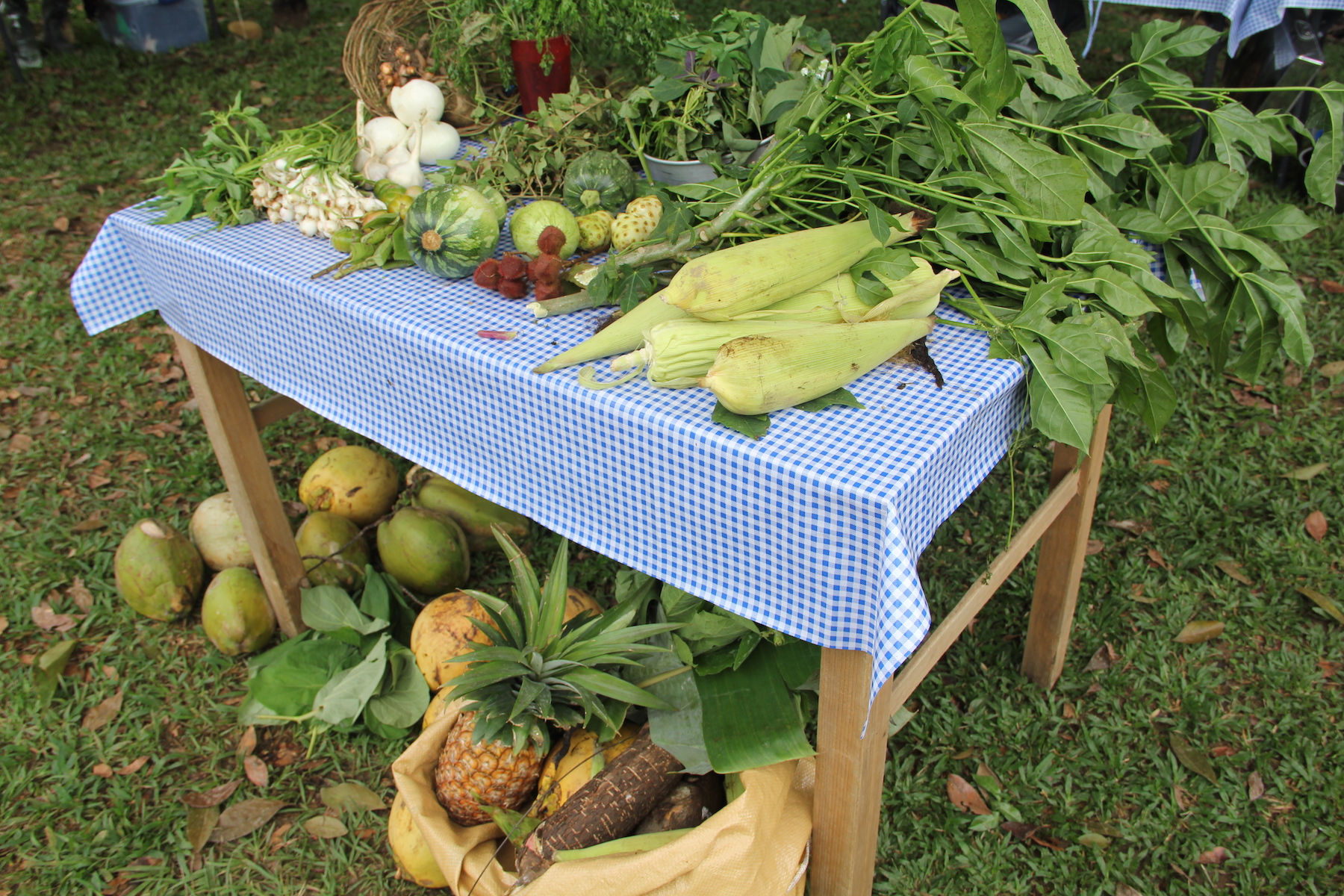
YUCA AND ORGANIC FARMING
January 26, Ejido Boca de Chajúl
Chefs Alam Mendez and Pau Ballesteros
Only few farmers from the ejido Boca de Chajul grow their food in an organic way. These farmers however are ridiculed by other producers who prefer to use agro-chemicals in their crops, not only affecting the health of consumers, but also the soil fertility in their parcels and the ecosystems that surround them. During the project we created a platform to encourage those who stand out and decide to experiment beyond the traditional monoculture practices, that showcased their achievements to the rest of the community, and linking them to researchers that could help them evaluate different forms of sustainable management; in the future, the lab could create market links to their products inside and outside of the region.

GARDEN AND FIELD CONSERVES
February 2, Ejido Flor de Marqués
Chef Pau Ballesteros
The community members of the Ejido Flor de Marques manage an ecotourism project, a camp site called Tamandua, as a joint effort to maintain a local economy that does not depend on the slashing of the rainforest. On request we dedicated the action to conserves, as the local conditions made it hard to keep fresh vegetables and fruits that were harvested from the parcels and kitchen gardens. To be able to offer something unique from the area to their guests at the campsite, for example the wild papaya, we invented all types of conserve recipes that would give an added value to the products that are consumed and served in this town.
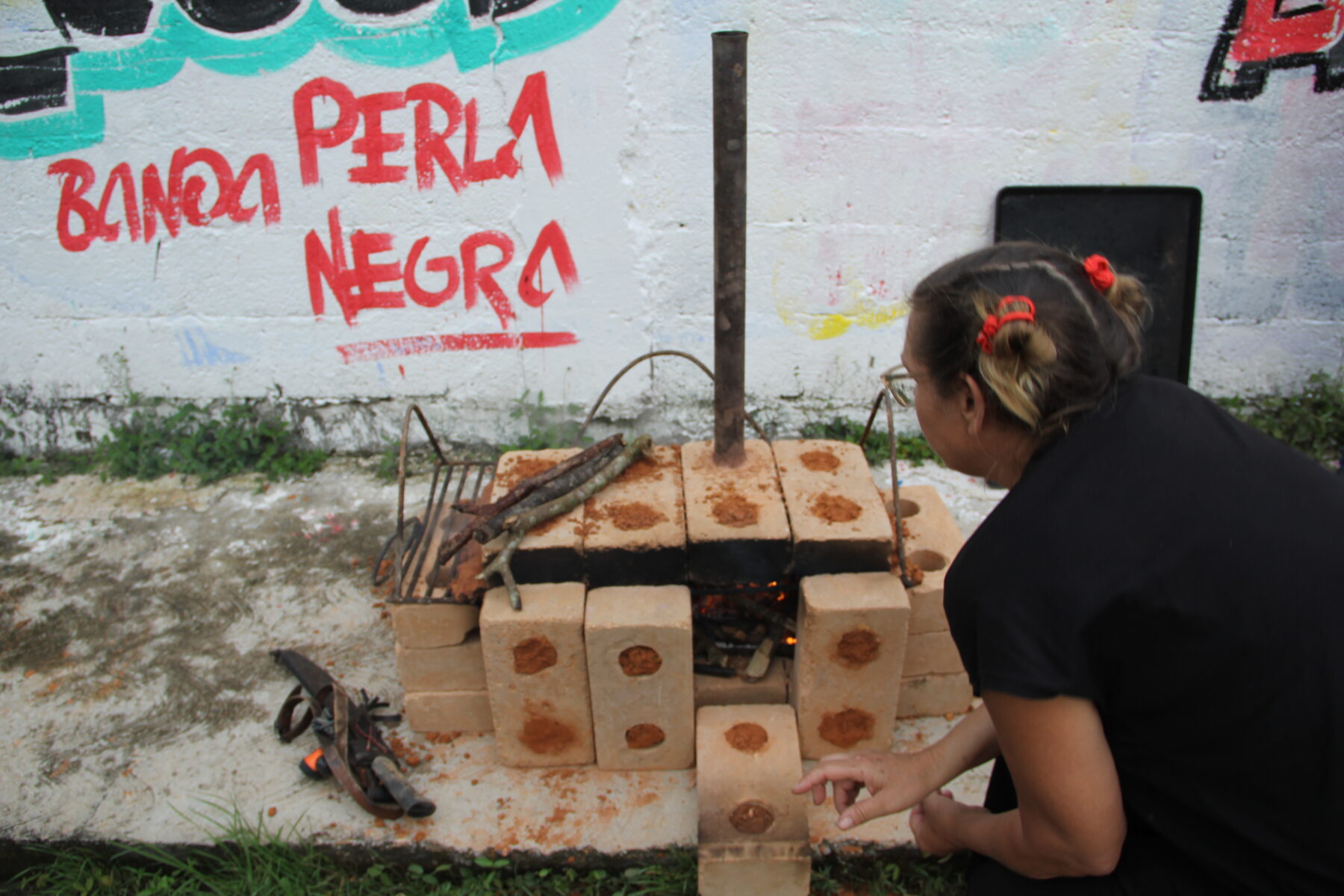

STREET OVENS FOR FISH AND PIZZA
February 3rd, Ejido Boca de Chajul
Chef Pau Ballesteros
Low-tech tools made by materials found easily in the area, open up opportunities to exchange foods and cooking methods in the street. During an action activated in the main boulevard of Chajul, we built on-site ovens and had an informal gathering with the bakers and fishers from the town. This central public space opened in a way to the possibilities of action and activation of different members of the community, who appropriated the street cooking.

KNOWLEDGE EXCHANGE MARKET
February 5, Ejido Boca de Chajul
Chefs Daniel Nates and Pau Ballesteros
Researchers from UNAM and WUR shared their stories and visions with the inhabitants of Ejido Boca de Chajul, during a market which brought together all the actions that Cascoland had previously executed, adding new tools co-designed with individuals from the research group.
A station which aim was to evaluate the relationship between younger generations of the ejido and the nature that surrounds them and a mobile radio station where tools that were developed through the event. Chefs Pau and Daniel experimented with new recipes of green cacao in conserves and smoked organic vegetables.
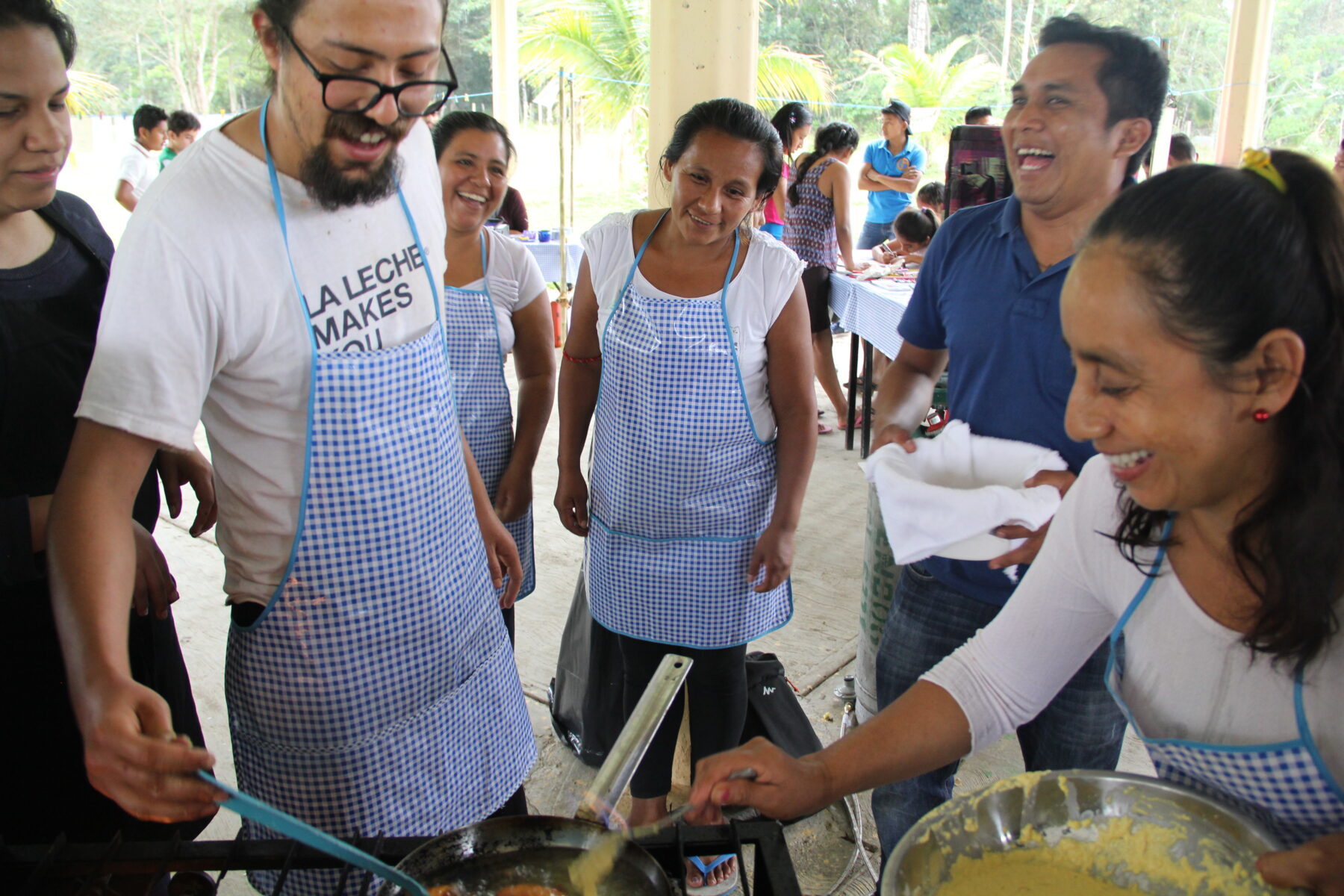
AXIOTE, TOMATO CONSERVES AND ORGANIC PRODUCTION
February 14th, Ejido Loma Bonita
Chef Daniel Nates and Foodhunter
Researchers of UNAM and WUR have been researching the Loma Bonita since 1994. Since then they have developed experiments to monitor forest regeneration and landscape restoration in abandoned parcels. The community of Loma Bonita however, has low access to that scientific knowledge, which could help them to generate new ways of productive agriculture. In this action chef Daniel Nates and Viridiana Valerio from FoodHunterMx researched the potential of Axiote and kidney tomato, grown abundantly in the town’s parcels.
Visit also:
Marqués de Comillas, Chiapas, México
Pilot Interventions in Ejidos of Chiapas
Cooking and exchanging in the frontier of the Lacandona Rainforest

The Dutch collective Cascoland joins Mexican creatives, UNAM and University of Wageningen researchers, in generating communication bridges between academics and ejidatarios of the Marqués de Comillas municipality, Chiapas, in search of a social and environmental development for the area.
Visiting the jungles of Chiapas, Cascoland didn’t bring much more than a kitchen table. Together with local cooks the team prepared food, exploring a new culinary culture using locally sourced products, materials and techniques. In doing so, exchanging ideas on a more balanced lifestyle that reconciles food production with the conservation of the tropical rainforest and can help improve the quality of life at the border of the Lacandon Jungle.
The Marqués de Comillas municipality, located on the southeast border of the Montes Azules reserve, has undergone a drastic landscape change in the last 40 years; from the establishment of ejidos formed by communities from different states of the Mexican republic, which depend on agriculture and livestock for economic sustenance. For this reason, the region is of great importance to understand how to reconcile the conservation of the forest with the integral development of the communities that inhabit it.
The Cascoland project – Keepers Lab&Kitchen – aims to generate spaces for meeting, dialogue and knowledge sharing using food as a central element, staged by arts and design. As a starting point for a long-term collaboration, the group has formulated a first intervention: creating meetings between different groups working and living in the area around a mobile culinary lab using the kitchen table like the catalyst for exchange.
In January and February 2018, the 15 members of the Cascoland collective, half Dutch and half Mexican, made up of artists, chefs, architects, sociologists, designers and video-audio makers; carried out a pilot of the Lab&Kitchen, in which they visited 5 ejidos of the region. An ejido is a commonly owned self-organised farmed land. Marqués de Comillas is composed of different Ejidos, each of them managed differently, focused on different agricultural produce and with different culinary cultures.
Around the kitchen tables, sharing and cooking, stories were exchanged about local consumption, the origin of edible products, agriculture, jungle resources and culinary traditions in the area. The actions taken to the different ejidos are part of a collective work methodology, in which participation is encouraged through activations of public spaces that allow creative exchange. The kitchen table was used as a metaphor for the exchange of this knowledge, activating the collaboration between the different actors.
Different tools for communication were tested in these interventions, such as mobile radios, home kitchens, dialogue tables and a mobile print press for recipe books. These tools will be further designed in the long run for establishing a permanent Lab&Kitchen. In the future, these interdisciplinary communities will work together to build a location in Marqués de Comillas, where residents can be part of a program that allowing the design of new proposals for the regeneration and conservation of forests and a cultural and economic development of the area.



This project was funded by Stimuleringsfonds for Creative Industries, “Climate Action Challenge” by What Design Can Do 2017, and UNAM through the project Reserbos, INREF-FOREFRONT-WUR.
Collaborators
Local
Rafa Lombera
Communities from Loma Bonita, Chajúl, El Pirú, Flor de Marqués y Adolfo López Mateos
Creatives
Fiona de Bell
Roel Schoenmakers
Femke Bijlsma
Mariana Martínez Balvanera
Jesper Buursink
Bart Majoor
Szolt Kamaras
Elizabeth Guerrero
Abraham Soriano
Sara Perez
Bruno Ruiz
Michelle Ponce
Chefs
Pau Ballesteros
Daniel Nates
Alam Méndez
FoodHunter MX (Viridiana Valerio)
Academics
Miguel Martínez
Patricia Balvanera
Franz Bonghers
Thom Kuipers
Carolina Berget
Antonio Castro
Aline Pingarroni
Diego Hernández
Marqués de Comillas, Chiapas, México
Keepers Lab&Kitchen
Bridging the gap between scientist and communities

Solutions and Knowledge are there. Design is needed to connect the theory and the practice. KEEPERS brings the connections to the table.
Dealing with the effects of climate change is not simply a matter of technological ingenuity or smart applications. It’s complex stuff. It takes good collaboration, on all levels, to actually trigger change. People with various perspectives need to connect. But it’s exactly that connection that’s missing.
In early 2018 the region of Marques de Comillas will be hosting the first KEEPERS pilot. The design and programming of KEEPERS will be shaped following Cascoland’s unique methodology: designing short-term interventions, tools for meeting and communication, creating public space, and collective moments. This way design works to bridge communication gaps, unlocking humanity’s potential to solve problems together.
Video produced by Cascoland for the Climate Action Challenge from What Design Can Do, winner of the challenge for funding to develop the Pilot in 2018.
Collaborators
Fiona de Bell
Bart Majoor
Femke Bijlsma
Mariana Martínez Balvanera
Roel Schoenmakers
Visit also:
Cocina Colaboratorio is a transdisciplinary collective that brings together communities of people dedicated to agriculture, cooking, art, design, architecture, and research around the kitchen table to exchange knowledge, design, and implement actions for a sustainable food future. It is a laboratory of collective creation and joint experimentation that seeks to reconcile the care of nature with food production and diverse ways of life.
In this section, you will find stories of actions in three territories through three arenas: the Kitchen, the Experimental Plot, and the Living Biocultural Archive. We also share research-action projects, public programs, and exchanges through Extended Table, as well as stories about resources for other collectives.